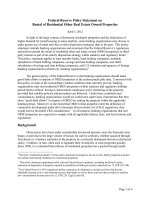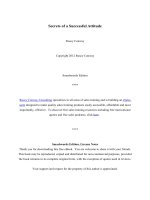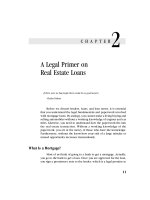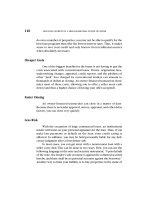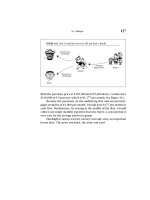Dearborn Financing Secrets of a Millionaire Real Estate Investor 2003_1 pot
Bạn đang xem bản rút gọn của tài liệu. Xem và tải ngay bản đầy đủ của tài liệu tại đây (592.79 KB, 21 trang )
This publication is designed to provide accurate and authoritative information in
regard to the subject matter covered. It is sold with the understanding that the pub-
lisher is not engaged in rendering legal, accounting, or other professional service. If
legal advice or other expert assistance is required, the services of a competent pro-
fessional person should be sought.
Vice President and Publisher: Cynthia A. Zigmund
Editorial Director: Donald J. Hull
Senior Managing Editor: Jack Kiburz
Interior Design: Lucy Jenkins
Cover Design: Design Alliance, Inc.
Typesetting: Elizabeth Pitts
2003 by William Bronchick
Published by Dearborn Trade Publishing
A Kaplan Professional Company
All rights reserved. The text of this publication, or any part thereof, may not be repro-
duced in any manner whatsoever without written permission from the publisher.
Printed in the United States of America
030405060710987654321
Library of Congress Cataloging-in-Publication Data
Bronchick, William.
Financing secrets of a millionaire real estate investor / William
Bronchick.
p. cm.
Includes index.
ISBN 0-7931-6820-1
(
7.25
×
9 pbk.)
1. Mortgage loans—United States. 2. Secondary mortgage
market—United States. 3. Real property—United States—Finance. 4.
Real estate investment—United States—Finance. I. Title.
HG2040.5.U5B767 2003
332.7
′
22—dc21
2003000057
Dearborn Trade books are available at special quantity discounts to use for sales pro-
motions, employee premiums, or educational purposes. Please call our Special Sales
Department, to order or for more information, at 800-621-9621, ext. 4404, or e-mail
v
C
ONTENTS
1. Introduction to Real Estate Financing
1
Understanding the Time Value of Money 2
The Concept of Leverage 2
Owning Property “Free and Clear” 5
How Financing Affects the Real Estate Market 6
How Financing Affects Particular Transactions 7
How Real Estate Investors Use Financing 8
When Is Cash Better Than Financing? 9
What to Expect from This Book 10
Key Points 10
2. A Legal Primer on Real Estate Loans
11
What Is a Mortgage? 11
Promissory Note in Detail 12
The Mortgage in Detail 14
The Deed of Trust 15
The Public Recording System 15
Priority of Liens 16
What Is Foreclosure? 17
Judicial Foreclosure 17
Nonjudicial Foreclosure 18
Strict Foreclosure 19
Key Points 19
3. Understanding the Mortgage Loan Market
21
Institutional Lenders 21
Primary versus Secondary Mortgage Markets 22
Mortgage Bankers versus Mortgage Brokers 23
Conventional versus Nonconventional Loans 25
Conforming Loans 25
Nonconforming Loans 28
vi
CONTENTS
Government Loan Programs 28
Federal Housing Administration Loans 29
The Department of Veterans Affairs 30
State and Local Loan Programs 31
Commercial Lenders 31
Key Points 32
4. Working with Lenders 33
Interest Rate 33
Loan Amortization 34
15-Year Amortization versus 30-Year Amortization 36
Balloon Mortgage 37
Reverse Amortization 38
Property Taxes and Insurance Escrows 38
Loan Costs 39
Origination Fee 39
Discount Points 39
Yield Spread Premiums: The Little Secret Your Lender
Doesn’t Want You to Know 39
Loan Junk Fees 40
“Standard” Loan Costs 41
Risk 44
Nothing Down 45
Loan Types 46
Choosing a Lender 48
Length of Time in Business 49
Company Size 50
Experience in Investment Properties 50
How to Present the Deal to a Lender 51
Your Credit Score 52
Your Provable Income 56
The Property 56
Loan-to-Value 58
The Down Payment 59
Income Potential and Resale Value of the Property 60
Financing Junker Properties 60
Refinancing—Worth It? 61
Filling Out a Loan Application 61
Key Points 62
CONTENTS
vii
5. Creative Financing through Institutional Lenders
63
Double Closing—Short-Term Financing without Cash 63
Seasoning of Title 65
The Middleman Technique 67
Case Study #1: Tag Team Investing 69
Case Study #2: Tag Team Investing 70
Using Two Mortgages 71
No Documentation and Nonincome Verification Loans 72
Develop a Loan Package 75
Subordination and Substitution of Collateral 76
Case Study: Subordination and Substitution 77
Using Additional Collateral 79
Blanket Mortgage 79
Using Bonds as Additional Collateral 80
Key Points 82
6. Hard Money and Private Money
83
Emergency Money 83
Where to Find Hard-Money Lenders 84
Borrowing from Friends and Relatives 85
Using Lines of Credit 86
Credit Cards 86
Key Points 87
7. Partnerships and Equity Sharing
89
Basic Equity-Sharing Arrangement 90
Scenario #1: Buyer with Credit and No Cash 90
Scenario #2: Buyer with Cash and No Credit 91
Your Credit Is Worth More Than Cash 91
Tax Code Compliance 92
Pitfalls 93
Alternatives to Equity Sharing 93
Joint Ventures 94
Using Joint Venture Partnerships for Financing 94
Legal Issues 95
Alternative Arrangement for Partnership 95
Case Study: Shared Equity Mortgage with Seller 96
When Does a Partnership Not Make Sense? 97
Key Points 98
viii
CONTENTS
8. The Lease Option
99
Financing Alternative 100
Lease—The Right to Possession 100
Sublease 100
Assignment 100
More on Options, the “Right” to Buy 101
An Option Can Be Sold or Exercised 102
Alternative to Selling Your Option 102
The Lease Option 103
The Lease Purchase 103
Lease Option of Your Personal Residence 104
The Sandwich Lease Option 106
Cash Flow 107
Equity Buildup 107
Straight Option without the Lease 108
Case Study: Sandwich Lease Option 109
Sale-Leaseback 110
Case Study: Sale-Leaseback 111
Key Points 112
9. Owner Financing
113
Advantages of Owner Financing 115
Easy Qualification 115
Cheaper Costs 116
Faster Closing 116
Less Risk 116
Future Discounting 117
Assuming the Existing Loan 117
Assumable Mortgages 117
Assumable with Qualification 118
Buying Subject to the Existing Loan 118
Risk versus Reward 119
Convincing the Seller 120
A Workaround for Down-Payment Requirements 121
Installment Land Contract 122
Benefits of the Land Contract 124
Problems with the Land Contract 125
Using a Purcahse Money Note 125
Variation: Create Two Notes, Sell One 126
Another Variation: Sell the Income Stream 126
CONTENTS
ix
Wraparound Financing 127
The Basics of Wraparound Financing 127
Wraparound versus Second Mortgage 130
Mirror Wraparound 132
Wraparound Mortgage versus Land Contract 133
Key Points 133
10. Epilogue
135
Appendix A Interest Payments Chart 139
Appendix B State-by-State Foreclosure Guide 141
Appendix C Sample Forms 143
Uniform Residential Loan Application
[
FNMA Form 1003
]
144
Good Faith Estimate of Settlement Costs 148
Settlement Statement
[
HUD-1
]
149
Note
[
Promissory—FNMA
]
151
California Deed of Trust
(
Short Form
)
153
Mortgage
[
Florida—FNMA
]
155
Option to Purchase Real Estate
[
Buyer-Slanted
]
171
Wrap Around Mortgage
[
or Deed of Trust
]
Rider 173
Installment Land Contract 174
Subordination Agreement 176
Glossary 179
Resources 187
Suggested Reading 187
Suggested Web Sites 188
Real Estate Financing Discussion Forums 188
Index 189
1
CHAPTER
1
Introduction to Real
Estate Financing
Knowledge is power.
—Francis Bacon
In 1991, I made my first attempt at financing an investment prop-
erty through creative means. With a lot of guts and a little knowledge,
I made an offer that was accepted by the seller. I tendered $1,000 as
earnest money on the sales contract, then proceeded to try to make
the deal work. I failed, lost my $1,000, but I learned an important les-
son—a little knowledge can be dangerous. I decided then to become a
master at real estate finance.
Financing has traditionally been, and will always be, an integral
part of the purchase and sale of real estate. Few people have the funds
to purchase properties for all cash, and those that do rarely sink all of
their money in one place. Even institutional and corporate buyers of
real estate use borrowed money to buy real estate.
This book explains how to utilize real estate financing in the
most effective and profitable way possible. Mostly, this book focuses
on acquisition techniques for investors, but these techniques are also
applicable to potential homeowners.
2
FINANCING SECRETS OF A MILLIONAIRE REAL ESTATE INVESTOR
Understanding the Time Value of Money
In order to understand real estate financing, it is important that
you understand the time value of money. Because of inflation, a dollar
today is generally worth less in the future. Thus, while real estate val-
ues may increase, an all-cash purchase may not be economically feasi-
ble, because the investor’s cash may be utilized in more effective ways.
The cost of borrowing money is expressed in interest payments,
usually a percent of the loan amount. Interest payments can be calcu-
lated in a variety of ways, the most common of which is simple inter-
est. Simple interest is calculated by multiplying the loan amount by the
interest rate, then dividing it up into period
(
12 months, 15 years, etc
)
.
Example:
A $100,000 loan at 12% simple interest is $12,000
per year, or $1,000 per month. To calculate monthly simple-
interest payments, take the loan amount
(
principal
)
, multiply
it by the interest rate, and then divide by 12. In this example,
$100,000 × .12 = $12,000 per year ÷ 12 = $1,000 per month.
Mortgage loans are generally not paid in simple interest but
rather by amortization schedules
(
discussed in Chapter 4
)
, calculated
by amortization tables
(
see Appendix A
)
.
Amortization,
derived from
the Latin word “amorta”
(
death
)
, is to pay down or “kill” a debt. Amor-
tized payments remain the same throughout the life of the loan but are
broken down into interest and principal. The payments made near the
beginning of the loan are mostly interest, while the payments near the
end are mostly principal. Lenders increase their return and reduce
their risk by having most of the profit
(
interest
)
built into the front of
the loan.
The Concept of Leverage
Leverage
is the process of using borrowed money to make a re-
turn on an investment. Let’s say you bought a house using all of your
cash for $100,000. If the property were to increase in value 10 percent
☛
1 / Introduction to Real Estate Financing
3
The Federal Reserve and Interest Rates
The Federal Reserve
(
the Fed
)
is an independent
entity created by an Act of Congress in 1913 to
serve as the central bank of the United States.
There are 12 regional banks that make up the Fed-
eral Reserve System. While the regional banks are
corporations whose stock is owned by member
banks, the shareholders have no influence over the
Federal Reserve banks’ policies.
Among other things, the function of the Fed is
to try to regulate inflation and credit conditions in
the U.S. economy. The Federal Reserve banks also
supervise and regulate depository institutions.
So how does the Fed’s policy affect interest
rates on loans? To put it simply, by manipulating
“supply and demand.” The Fed changes the money
supply by increasing or decreasing reserves in the
banking system through the buying and selling of
securities. The changes in the money supply, in
turn, affect interest rates: the lower the supply of
money, the higher the interest rate that is charged
for loans between banks. The more it costs a bank
to borrow money, the more they charge in interest
to consumers to borrow that money. The preced-
ing is a simplified explanation, because there are
other factors in the world economy that affect
interest rates and money supply. And, of course,
there are also widely varying opinions by econo-
mists as to what factors drive the economy and
interest rates.
4
FINANCING SECRETS OF A MILLIONAIRE REAL ESTATE INVESTOR
over 12 months, it would now be worth $110,000. Your return on in-
vestment would be 10 percent annually
(
of course, you would actually
net less because you would incur costs in selling the property
)
.
Equity = Property value – Mortgage debt
If you purchased a property using $10,000 of your own cash and
$90,000 in borrowed money, a 10 percent increase in value would
still result in $10,000 of increased equity, but your return on cash is
100 percent
(
$10,000 investment yielding $20,000 in equity
)
. Of
course, the borrowed money isn’t free; you would have to incur loan
costs and interest payments in borrowing money. However, by rent-
ing the property in the meantime, you would offset the interest
expense of the loan.
Let’s also look at the income versus expense ratios. If you pur-
chased a property all cash for $100,000 and collected $1,000 per
month in rent, your annual cash-on-cash return is 12 percent
(
simply
divide the annual income, $12,000, by the amount of cash invested,
$100,000
)
.
If you borrowed $90,000 and the payments on the loan were
$660 per month, your annual net income is $4,080
(
$12,000 –
[
$660
× 12
])
, but your annual cash-on-cash return is about 40 percent
(
annual cash of $4,080 divided by $10,000 invested
)
.
Calculating Return on Investment
Annual return on investment
(
ROI
)
is the interest
rate you yield on your cash investment. It is calcu-
lated by taking the annual cash flow or equity
increase and dividing it by the amount of cash
invested.
1 / Introduction to Real Estate Financing
5
So, if you purchased ten properties with 10 percent down and
90 percent financing, you could increase your overall profit by more
than threefold. Of course, you would also increase your risk, which
will be discussed in more detail in Chapter 4.
Owning Property “Free and Clear”
For some investors, the goal is to own properties “free and clear,”
that is, with no mortgage debt. While this is a worthy goal, it does not
necessarily make financial sense. See Figure 1.1.
FIGURE 1.1
Owning Free and Clear versus Mortgaging
100%
Free and
Clear
90%
Financing
FREE AND CLEAR PROPERTY
Value = $100,000
Cash Investment = $100,000
Annual Net Income = $12,000
Return on Investment = 12%
90% FINANCED PROPERTY
Value = $100,000
Cash Investment = $10,000
Annual Net Income = $4,080
Return on Investment = 40.8%
10% Down
Payment
6
FINANCING SECRETS OF A MILLIONAIRE REAL ESTATE INVESTOR
Example:
Consider a $100,000 property that brings in
$10,000 per year in net income
(
net
means gross rents col-
lected, less expenses, such as property taxes, maintenance,
utilities, and hazard insurance
)
. The $100,000 in equity thus
yields a 10 percent annual return on investment
(
$10,000,
the annual net cash flow, divided by $100,000, the equity
investment
)
.
If the property were financed for 80 percent of its value
(
$80,000
)
at 7.5 percent interest, the monthly payment would be approximately
$560 per month, or $6,720 per year. Net rent of $10,000 per year
minus $6,720 in debt payments equals $3,280 per year in net cash
flow. Divide the $3,280 in annual cash flow by the $20,000 in equity
and you have a 16.4 percent return on investment. Furthermore, with
$80,000 more cash, you could buy four more properties. As you can
see, financing, even when you don’t necessarily “need” to do so, can
be more profitable than investing all of your cash in one property.
How Financing Affects the Real Estate Market
Because financing plays a large part in real estate sales, it also af-
fects values; the higher the interest rate, the larger your monthly pay-
ment. Conversely, the lower the interest rate, the lower the monthly
payment. Thus, the lower the interest rate, the larger the mortgage
loan you can afford to pay. Consequently, the larger the mortgage you
can afford, the more the seller can ask for in the sales prices.
Also, people with less cash are usually more concerned with
their payment than the total amount of the purchase price or loan
amount. On the other hand, people with all cash are more concerned
with price. Because most buyers borrow most of the purchase price,
the prices of houses are affected by financing. Thus, when interest
rates are low, housing prices tend to increase, because people can
afford a higher monthly payment. Conversely, when interest rates are
higher, people cannot afford as much a payment, generally driving
real estate prices down.
☛
1 / Introduction to Real Estate Financing
7
Since the mid-1990s, the prices of real estate have dramatically
increased in most parts of the country. The American economy has
grown, the job growth during this period has been good, but most
important, interest rates have been low.
How Financing Affects Particular Transactions
When valuing residential properties, real estate appraisers gener-
ally follow a series of standards set forth by professional associations
(
the most well-known is the Appraisal Institute
)
. Sales of comparable
properties are the general benchmark for value. Appraisers look not
just at housing sale prices of comparable houses, but also at the
financing associated with the sales of these houses. If the house was
owner-financed
(
discussed in Chapter 9
)
, the interest rate is generally
higher than conventional rates and/or the price is inflated. The price
is generally inflated because the seller’s credit qualifications are
looser than that of a bank, which means the buyer will not generally
complain about the price.
Take a Cue from Other Industries
The explosion of the electronics market, the auto-
mobile market, and other large-ticket purchase
markets is directly affected by financing. Just
thumb through the Sunday newspapers and you
will see headlines such as “no money down” or
“no payments for one year.” These retailers have
learned that financing moves a product because it
makes it easier for people to justify the purchase.
Likewise, the price of a house may be stretched a
bit more when it translates to just a few dollars
more per month in mortgage payments.
8
FINANCING SECRETS OF A MILLIONAIRE REAL ESTATE INVESTOR
Appraisals on income properties are done in a variety of ways,
one of which is the “income” approach. The
income approach
looks
at the value of the property versus the rents the property can pro-
duce. While financing does not technically come into the equation, it
does affect the property’s profitability to the investor. Thus, a prop-
erty that can be financed at a lower interest rate will be more attrac-
tive to the investor if cash flow is a major concern.
How Real Estate Investors Use Financing
As discussed above, investors use mortgage loans to increase
their leverage. The more money an investor can borrow, the more he
or she can leverage the investment. Rarely do investors use all cash to
purchase properties, and when they do, it is on a short-term basis.
They usually refinance the property to get their cash back or sell the
property for cash.
Tax Impact of Financing
Down payments made on a property as an investor
are not tax-deductible. In fact, a large down pay-
ment offers no tax advantage at all because the in-
vestor’s tax basis is based on the purchase price,
not the amount he or she puts down. However, be-
cause mortgage interest is a deductible expense,
the investor does better tax wise by saving his or
her cash. Think about it: the higher the monthly
mortgage payment, the less cash flow, the less tax-
able income each year. While positive cash flow is
desirable, it does not necessarily mean that a prop-
erty is more profitable because it has more cash
flow. A larger down payment will obviously in-
crease monthly cash flow, but it is not always the
best use of your money.
1 / Introduction to Real Estate Financing
9
The challenge is that loans for investors are treated as high-risk
by lenders when compared to noninvestor
(
owner-occupied proper-
ties
)
loans. Lenders often look at leveraged investments as risky and
are less willing to loan money to investors. Lenders assume
(
often cor-
rectly
)
that the less of your own money you have invested, the more
likely you will be to walk away from a bad property. In addition, fewer
investor loan programs mean less competition in the industry, which
leads to higher loan costs for the investor. The goal of the investor thus
is to put forth as little cash as possible, pay the least amount in loan
costs and interest, while keeping personal risk at a minimum. This is
quite a challenge, and this book will reveal some of the secrets for
accomplishing this task.
When Is Cash Better Than Financing?
Using all cash to purchase a property may be better than financ-
ing in two particular situations. The first situation is a short-term deal,
that is, you intend to sell the house shortly after you buy it
(
known as
“flipping”
)
. When you have the cash to close quickly, you can gener-
ally get a tremendous discount on the price of a house. In this case,
financing may delay the transaction long enough to lose an opportu-
nity. Cash also allows you to purchase properties at a larger discount.
You’ve heard the expression, “money talks, BS walks.” This is particu-
larly true when making an offer to purchase a property through a real
estate agent. The real estate agent is more likely to recommend to his
or her client a purchase offer that is not contingent on the buyer
obtaining bank financing.
The second case is one in which you can use your retirement ac-
count. You can use the cash in your IRA or SEP to purchase real estate,
and the income from the property is tax-deferred. In order to do this,
you need an aggressive self-directed IRA custodian
(
oddly enough,
most IRA custodians view real estate as “risky” and the stock market as
“safe”
)
. Two such custodians are Mid Ohio Securities,
<
www.mi
doh.com
>
, or Entrust Administration,
<
www.entrustadmin.com
>
.
10
FINANCING SECRETS OF A MILLIONAIRE REAL ESTATE INVESTOR
What to Expect from This Book
This book will show you how to finance properties with as little
cash as possible, while maintaining minimum risk and maximum
profit.
The first few chapters describe the mortgage loan process, legal
details, and the banking industry. Chapter 4 covers different types of
lenders and loans, and the benefits of each. Chapter 5 covers how to
creatively use institutional loan programs as an investor. Chapters 6,
7, 8, and 9 cover creative, noninstitutional financing.
As with any technique on real estate acquisition or finance, you
should review the process with a local professional, including an attor-
ney. Also, keep in mind that while most of these ideas are applicable
nationwide, local practices, laws, rules, customs, and market condi-
tions may require variations or adaptations for your particular use.
Key Points
•
Interest rates affect property values.
•
Financing affects the value of a property to an investor.
•
Investors use financing to leverage their investments.
Understanding a Cash Offer
versus Paying All Cash
If you make a “cash offer” on a property, it does not
necessarily mean you are using all of your own
cash. It means the seller is receiving all cash, as op-
posed to the seller financing some part of the pur-
chase price
(
discussed more fully in Chapter 9
)
.

